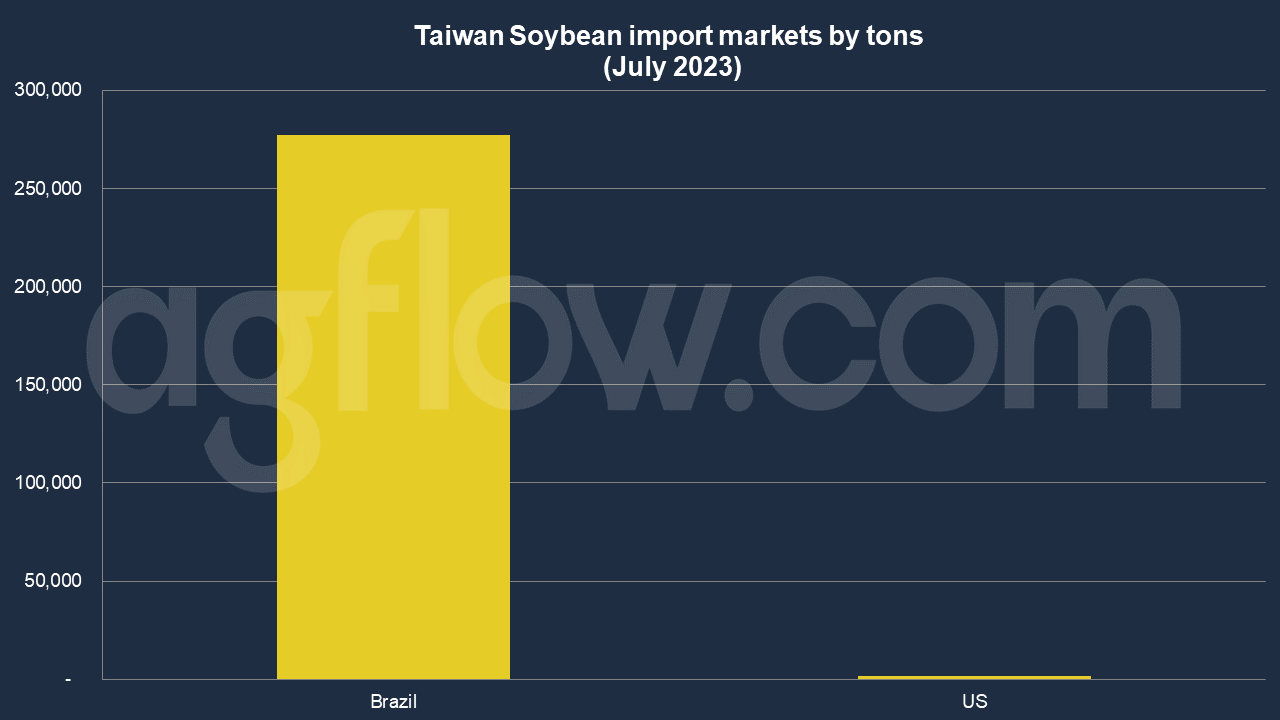Taiwan Soybean Import: Brazil Dominates With 74% Market Share
Talk to our team about AgFlow's offering →
Reading time: 2 minutes
Taiwan, an island nation known for its technological advancements and bustling economy, has a lesser-known but equally vital connection to the global agricultural commodity industry. The soybean trade in Taiwan is a complex web of import and export activities that has seen significant changes in the first half of 2023. Let’s dive into the intricate world of soybeans and explore what makes this trade so essential for Taiwan.
Key Factors Impacting Taiwan’s Soybean Trade
1. Global Market Dynamics
The global soybean market is like a vast ocean, with waves that can either propel Taiwan’s trade forward or pull it back. In 2023, fluctuations in international prices, driven by factors such as weather conditions in major producing countries and global economic trends, have directly impacted Taiwan’s soybean trade. How does Taiwan navigate these turbulent waters? By maintaining a delicate balance between supply and demand and forging strategic partnerships with key suppliers.
2. Domestic Consumption Patterns
Imagine a seesaw, with Taiwan’s soybean consumption on one side and production on the other. In 2023, the seesaw has tilted towards increased consumption, driven by a growing preference for soy-based products. This shift has necessitated increased imports to meet domestic demand. But what are the tradeoffs? Increased reliance on imports can lead to vulnerability to global market fluctuations.
According to AgFlow data, Taiwan imported 0.3 million tons of Soybean from Brazil in July 2023, followed by the United States (1,567 tons). Total imports hit 1.2 million tons in Jan-July 2023. Taiwan was purchasing large amounts of Soybean from Brazil and the United States and Brazil, such as 215,400 tons and 204,380 tons, respectively.
July shipments were the largest in Jan – July of 2023, with 0.3 million tons. The following months were Feb (0.24 million tons), Jan (0.2 million tons), June (0.15 million tons), Apr (0.15 million tons), May (0.14 million tons), and Mar (20,000 tons).

3. Government Policies and Regulations
Think of government policies as the guardrails on the winding road of Taiwan’s soybean trade. They guide, support, and sometimes restrict the flow of trade. In 2023, policies aimed at promoting sustainable farming practices and ensuring food security have shaped the import and export landscape. But are these policies always in harmony with market dynamics? The challenge lies in crafting regulations that support domestic producers without stifling competitiveness in the global market.
Challenges and Tradeoffs: A Closer Look
Navigating the complex world of soybean trade is like steering a ship through a storm. The challenges are many, and the path is fraught with obstacles.
• Balancing Domestic Production and Imports: Taiwan’s increased consumption has led to a greater reliance on imports. But what happens if global prices soar or if key suppliers face production issues? The challenge is to strike the right balance between domestic production and imports to ensure a stable supply.
• Sustainability vs. Profitability: The push for sustainable farming practices is commendable but comes with costs. How does Taiwan ensure that these practices are economically viable for farmers? Finding the right balance between environmental stewardship and economic prosperity is a question.
• Global Partnerships and Geopolitical Considerations: Building strong relationships with key suppliers is vital. But what if geopolitical tensions arise? Navigating these complex relationships requires diplomatic finesse and strategic planning.
Conclusion
The soybean trade in Taiwan is more than just a matter of numbers and statistics. It’s a dynamic and multifaceted field that requires a deep understanding of global and domestic factors. The first half of 2023 has shown that Taiwan’s soybean trade is resilient and adaptable, but it also faces challenges that require careful consideration and strategic planning. Like a master chef balancing flavors in a complex dish, Taiwan must continue to blend various elements of trade, policy, and market dynamics to create a successful recipe for its soybean industry. The journey is ongoing, and the lessons learned will shape the future of this vital trade.
Try AgFlow Free
Access Free On Updates for Corn, Wheat, Soybean,
Barley, and Sunflower Oil.
No Credit Card Required & Unlimited Access In Time

